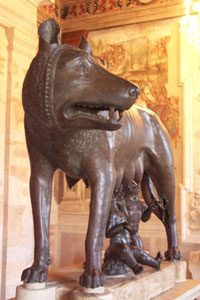
Villanovan cremation urn with helmet on top (ca. 900 BC)
Italy’s history in antiquity mostly followed the changes that were happening in West Asia a little earlier. The first modern people arrived in Italy from West Asia about 10,000 BC. About 5000 BC a second group of West Asian travellers brought farming and farm animals to Italy – Central Asian cows, West Asian sheep, and African donkeys.
When people started to use bronze in West Asia, about 3000 BC, people in Italy quickly learned how to use bronze as well. And then about 2000 BC, a third group of people came to Italy from Central Asia – the Indo-Europeans. The Indo-Europeans brought with them a new language, that eventually became Latin.
The Dark Age that affected Egypt, Greece and West Asia about 1200 BC doesn’t seem to have really mattered to the Romans, but afterwards the Romans continued to learn from West Asia. They learned to use iron in addition to bronze for their tools and weapons. Like people in West Asia and Greece, the Romans began to build cities and big stone buildings, and they experimented with their government – mainly kings watched over by a Senate of rich men.

Roman Republic
About 500 BC, two big changes happened in the eastern Mediterranean, and the Romans learned from both changes. First, in 536 BC Cyrus the Great conquered most of West Asia to form the Persian Empire – the first big empire in the world. By the mid 400s, the Romans (like the Athenians and the Carthaginians) were already following the Persians’ lead and beginning to take over their neighbors.

Bronze wolf from early Rome
Second, many cities in Greece and North Africa threw out their kings and let their Senates take over (in Athens, they experimented with democracy). In 509 BC, Rome did the same thing. By 275 BC the Romans ruled all of Italy; then they fought Carthage to control the whole Western Mediterranean. By 146 BC the Romans were already taking over the Eastern Mediterranean as well.
The Roman Empire
Bibliography and further reading about Roman history:
The Ancient Roman World, by Ronald Mellor (2004). Straight political history, For teens.
Classical Rome, by John Clare (1993). For kids, the whole political history from beginning to end.
The Romans: From Village to Empire, by Mary Boatwright, Daniel Gargola, and Richard Talbert (2004). Okay, it’s a little dry, but it is up to date and has all the facts you could want.